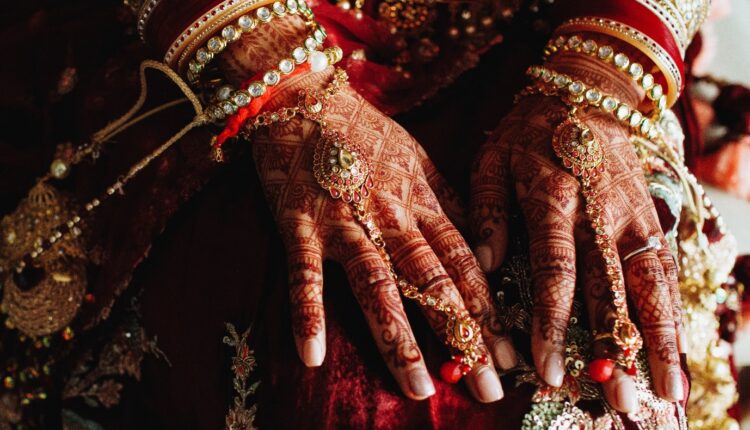Table of Contents
Let us talk about why there are 16 ornaments used in Indian weddings and what’s the significance of each of them for the bride and groom:
Top 15 ‘Solah Shringar’ Ornaments for the Bride
1. Bindi
Bindi represents the third eye and is placed at the centre of the forehead. It is believed that a woman’s beauty is tri-folded using a red bindi. It is also a symbol of a woman’s marital status.
2. Vermillion (Sindoor)
Sindoor is a blood-red powder applied on the parting of the forehead and hairline. It is a symbol of marriage and the bond between a husband and wife. Unmarried girls are not allowed to wear Sindoor as it is believed to drive sexual energy.
3. Maang Tikka
The Maang Tikka ornament is worn between the parting of the hairline and forehead. It is believed to symbolize the third eye and empower the intuitive power and spiritual energies.
4. Kajal or Anjana
The Kajal is a black powder mixed with a little oil. This powder is acquired from soot, the burnt wood. The Kajal is applied around the eye border to make them look enticing and give them a shape.
5. Nose Ring (Nath)
Nath or Nose Ring is worn by the married women to signify their marital status. It is believed that the pain during childbirth is lessened if the ring is worn at a proper place on the nose. It is a customer or a rule that a woman who is married or about to get married should only wear nose rings.
6. Ear Ornaments (Karn Phool)
A traditional ‘Jhumki’ or ‘Jhumka’ goes a long way to portray the beauty of the bride. They may also consist of elaborately decorated large round ornaments. These ear ornaments are a bit heavy in size and weight but often supported by a chain passing over the head.
7. Necklace (Haar)
The Necklace or locally known as ‘Haar’ is yet another and most precious ornament symbolic to prosperity. Usually, the Indian brides of the modern era prefer a single chic necklace with polka or even Kundan work. Diamonds are other favourites among the modern brides. A souvenir and an important item is the Mangalsutra which is worn by the bride by the hands of the groom himself when getting married.
8. Mehendi
In India, women beautify themselves almost on every occasion with Mehendi or Henna. This decoration of hands, arms and even feet is loved by even kids but on Marriages, it’s a necessity. These are the elaborate and most intricate expressions of art. Their religious significance in Hindu rituals is also very famous because of their ‘good’ qualities like keeping away misery, diseases and protection from evil.
9. Armband/Armlet (Baajuband)
This is like a bracelet. ‘Baaju’ meaning ‘Arm’; this accessory is worn on the upper arm and believed to keep away evil or wrong feelings towards the married couple. In modern times, sleek designs are more preferred and can be paired with any attire.
10. Bangles (Choodiyan)
Bangles or ‘Choodiyan’ are a classical accompaniment to any jewellery item as well as the Bridal Trousseau. These are worn to signify prosperity and goodwill of her new family. India being a cultural heritage, each culture has their own designs as well as names for their bangles.
11. Haathphool (Aarsi)
Rings are worn on fingers through which a chain (mostly gold chain) emerges over the hand and attaching it to the central motif. This is further followed by the chain which is connected to the bracelet. These are embellished with either precious gemstone or gold ornament with Kundan work. ‘Aarsi’ is a special thumb ring studded with a mirror, and it is designed in a way so that the bride can get a glimpse of her groom in it.
12. Waist Accessory (Kamarbandh)
This is a waistband that enhances the graceful shape of the female silhouette. It is made up of gold with the embellishment of gems. It is also used to keep the saree in place.
13. Anklets (Payal)
The Payal are kind of sleek chains worn around the Ankles to make charming jingling sounds as she walks. This is to draw attention to her presence and announce her entry into a new life. It’s noticeable that these are never made of gold but only silver because gold is highly respected in Hindu traditions and wearing it on the foot is a disrespectful and bad omen.
14. Toe Ring (Bichhua)
In Solah Shringar, not even feet are left unadorned. The toe rings are worn on the second toes. It is believed that this toe is connected to the uterus of a woman and helps in revitalising the reproductive organs.
15. Fragrance (Itar)
The ‘Itar’ is a fragrance made from flowers and the reason it is used as an important part of Solah Shringar is to keep the bride smelling fragrant during the long duration of wedding rituals.
16. Hair Accessory (Keshapasharachana)
This hair adornment is usually used to tie the bride’s hair in a braid or traditional bun style embellished with gold ornaments and/or flowers. Mostly Jasmine flowers are used for their long-lasting fragrance.



